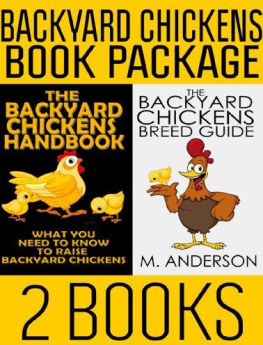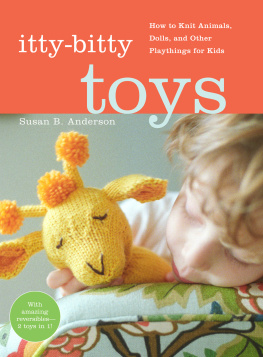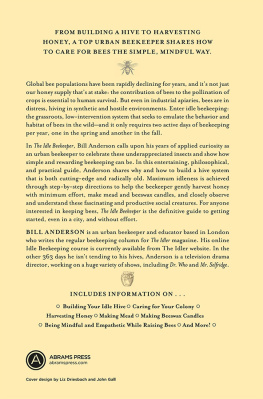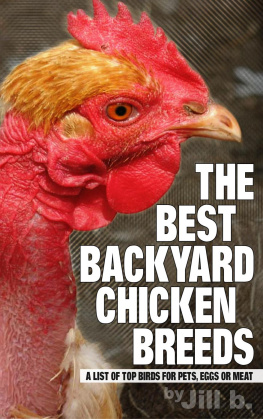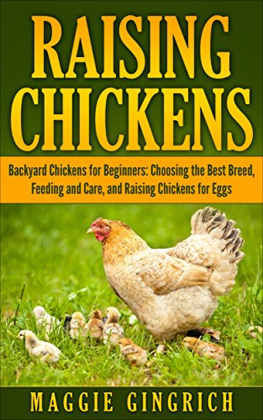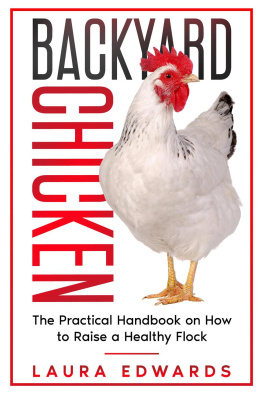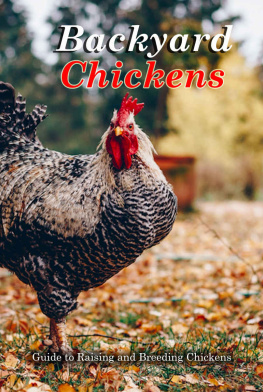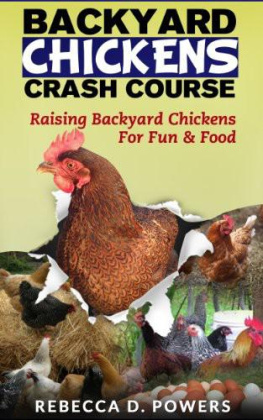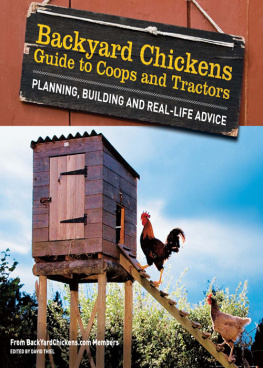Backyard Chickens Book Package: The Backyard Chickens Handbook and The Backyard Chickens Breed Guide
by M. Anderson
This book contains material protected under International and Federal Copyright Laws and Treaties. Any unauthorized reprint or use of this material is prohibited. No part of this book may be reproduced or transmitted in any form or by any means, electronic or mechanical, including photocopying, recording, or by any information storage and retrieval system without express written permission from the author.
2013, Michael Anderson All rights reserved.
Book 1
The Backyard Chickens Handbook: What You Need to Know to Raise Backyard Chickens
by M. Anderson
This book contains material protected under International and Federal Copyright Laws and Treaties. Any unauthorized reprint or use of this material is prohibited. No part of this book may be reproduced or transmitted in any form or by any means, electronic or mechanical, including photocopying, recording, or by any information storage and retrieval system without express written permission from the author.
2013, Michael Anderson All rights reserved.
Disclaimer:
The information contained in this book is for general information purposes only. The statements contained herein have not been evaluated nor approved by the US Food and Drug Administration. This book is sold with the understanding the author and/or publisher is not giving medical advice, nor should the information contained in this book replace medical advice, nor is it intended to diagnose or treat any disease, illness or other medical condition.
While we endeavor to keep the information up to date and correct, we make no representations or warranties of any kind, express or implied, about the completeness, accuracy, reliability, suitability or availability with respect to the book or the information, products, services, or related graphics contained book for any purpose. Any reliance you place on such information is therefore strictly at your own risk.
Dedication:
This book is dedicated to my loving wife, who's had to deal with my obsession with backyard chickens, survival skills and homesteading for many long years. I love you to death sweetie. Thanks for being so understanding.
Contents
What are Backyard Chickens?
Backyard chickens are small flocks of chickens that are kept by people looking to raise birds for meat, eggs or both. Most backyard chicken enthusiasts keep a flock of less than ten birds. It's estimated that hundreds of thousands of people across the United States keep backyard flocks, often in violation of local laws and ordinances.
These small flocks of chickens date back to a simpler time when people had to raise their own food or starve.
While it may seem quite distant, it wasn't that long ago that grocery stores where you could go buy any food you wanted simply didn't exist. People who wanted eggs and chicken meat either had to raise the birds themselves or barter for them by trading other goods or services. This led many people to raise small flocks of chickens in order to have a constant source of eggs and chicken meat.
Raising chickens dates back to a simpler time, where food was raised and harvested sustainably. Fast food didn't exist and processed food hadn't been invented. Our forefathers would be shocked to see what passes for food today and they'd be sickened to find out what's in it. Those with backyard flocks know just how bad the eggs and birds sold commercially have become. Once you try backyard eggs and chicken, you'll never want to go back to stuff sold in stores. There's really that big of a difference.
Terms You Need to Know
If you're new to the world of backyard chickens, the language and terms used can be rather confusing. Here are the terms you need to know in order to fit right in.
Backyard Chickens
Chickens grown in an urban setting, usually in a person's backyard.
Bantam
Bantam birds are smaller versions of normal chickens. They're ideal for those who are short on space. The eggs they lay are edible, but are smaller than normal chicken eggs. There are bantam versions of many of the most popular breeds.
Beak
The hard portion of a chicken's mouth.
Bedding
The material that's spread in the bottom of the coop to insulate the floor and wick away moisture.
Biddy
Another name for a hen.
Bloom
The protective coating covering a freshly-laid egg.
Breeder
Mature chicken used for fertilized eggs.
Broiler
A chicken that is raised for the sole purpose of eventually killing it and eating it. Broilers are usually plain white birds that grow to 4 to 5 pounds in 6 weeks, at which time they're harvested for meat.
Brooder
When baby chicks are born, they're moved into a brooder, which is a box or container that's kept warm and cozy until they develop feathers and are able to go out on their own.
Broody
A hen is said to have gone broody when her maternal instinct takes over and she has an uncontrollable desire to sit on a nest full of eggs. Broody hens will stop laying eggs until they're no longer broody.
Capon
A castrated rooster, typically raised for meat. Caponization happens after the rooster is six weeks of age and can be done surgically or through use of chemicals. Capons are calmer and less aggressive than normal roosters, and the meat matures differently. It's said to be of the highest quality and tastes different than that of normal chicken.
Candling
Using light to check an egg to make sure it's developing properly.
Cannibalism
The tendency of chickens to peck at one another's flesh and eggs.
Clutch
A group of eggs. The eggs a broody hen sits on is often referred to as her clutch.
Cock
A male chicken.
Cockerel
An adolescent male rooster.
Comb
The red piece of skin that stands up on top of a chicken's head.
Coop
A chicken house.
Diatomaceous Earth
Also known as DE. This is a powdery substance that actually isn't earth. It's made up of finely ground fossils and is used to kill parasites and mites, both internally and externally.
Dusting
Takes place when a bird covers itself in dust in an effort to prevent mites and parasites.
Hatch
A chick hatches when it leaves the egg.
Hen
A female chicken that has reached laying age.
Feed
The stuff your chickens eat.
Fryer
Young meat chicken.
Egg Tooth
The sharp portion of a chick's beak. It's used to chip away at the egg when the chick is ready to hatch.
Fertile Egg
A fertile egg is one that's laid after a rooster mates with the hen who lays it. Fertile eggs are the only eggs that can be hatched into chicks.
Free-Range
Chickens that are allowed to come and go as they please. Free-range chickens have access to a coop, but don't need a run because they're able to roam about your entire yard.
Heritage Chicken
A breed of chicken that has withstood the test of time. Heritage chickens are recognized by the American Poultry Association.
Incubator
A device used to keep chicken eggs warm until they hatch.
Laying Hen
A female chicken raised to lay eggs.
Litter
Another term for bedding.
Meat Bird
A chicken raised to be harvested for meat.
Molting
The shedding of feathers once a year.
Nesting Box
A box (or series of boxes) that are included as part of the coop. These boxes are where the hens lay their eggs.
Pecking Order
The chain of command in a flock. The chicken at the top of the pecking order dominates the rest of the chickens, while the chicken at the bottom is pushed around by the rest of the flock.
Pipping
Baby chicks are said to be pipping when they break out of their shells and hatch.
Next page
